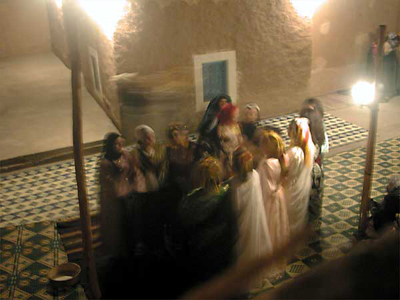Berber Culture
 The name Berber comes from the name given to this people by the Romans, meaning barbarians. The history of the Berber people in northern Africa is both extensive and diverse. Their oldest ancestors settled in the East of Egypt. Many are the references to this old People in greek, roman and phoenician texts. In fact berber is a generic name given to numerous heterogeneous ethnic groups who share similar cultural, political and economical practices.
The name Berber comes from the name given to this people by the Romans, meaning barbarians. The history of the Berber people in northern Africa is both extensive and diverse. Their oldest ancestors settled in the East of Egypt. Many are the references to this old People in greek, roman and phoenician texts. In fact berber is a generic name given to numerous heterogeneous ethnic groups who share similar cultural, political and economical practices.
The arabization of the Berber people happened in three stages. First it was the contact with arabic invaders in the 7th century. The second stage started with the arrival of the bedouins in the 11th century. And finally the 3rd stage took place between the 15th and 17th centuries and it was accelerated by the arrival of Andalusian refugees.
Contrary to the romantic, popular image that portrays Berbers as nomadic people who cross the desert in camels, their main activity is sedentary agriculture, which they carry out in mountains and valleys. But their long-recorded influence in trading in the region is also true. They were the first to open the commercial routes between Western Africa and Sub-Saharian Africa. They were responsible for bringing goods from beyond the Sahara desert to Northern african cities. Nowadays, besides the traditional means of living, there is a new element which is part of the economy of Berber families, namely income from the large number of immigrants in Europe, especially in France.
Berber society has traditionally been divided into farmers and merchants. Cultivation of the land was considered lower-class work whilst upper classes were merchants. Normally sedentary farming groups would pay tribute to a merchant local chief, as guarantee to be defended in return. However, as time went by, these farmers acquired a certain amount of wealth while, at the same time, the economical importance of commercial routes fell. Besides, these groups were given priority by colonial and post colonial authorities, in detriment of the traditional power merchants used to have.
About their architecture, it is as varied as the countries they live in. Berber constructions in the hills of Jebel Nebusa are among the most remarkable. They underground houses carved vertically or horizontally in limestone. Some of them look like ordinary caves on the slopes of hills. Others have been deeply dug on the ground and they have a complex net of rooms around a central hole which is used as a fountain.
As for their beliefs, since their conversion to Islam in the 7th century -they were mostly christians before- they have been faithful observants of its rules except for Ramadam fast that travellers are not obliged to follow. Like most Muslims in North Africa, many berbers believe in the continuous presence of several spirits (djinns). Divination is carried out through the Coran. Most men use protecting amulets which contain verses from The Coran.
In Morocco the Drawa Berbers inhabit the region of the river Dra Valley; The Dades live in the North East; The Mesgita, Seddrat and Zeri along inflowing rivers of the North West; The Ghomara live in the moroccan Rif, the north-eastern region of the country, north of Fez; The Kabyle, meaning "the tribes", originally referred to all berbers. However, nowadays the term covers only Berbers living in Al-Quabail Mountains, and The Sousi in High western Atlas Mountains.
Although the Berber language is basically oral, Berbers have had their own writing system, called tifinagh, for at least 2,500 years. At present this alphabet is used by the Tuaregs but the latin alphabet with a few variations and the arabic alphabet are the most commonly used